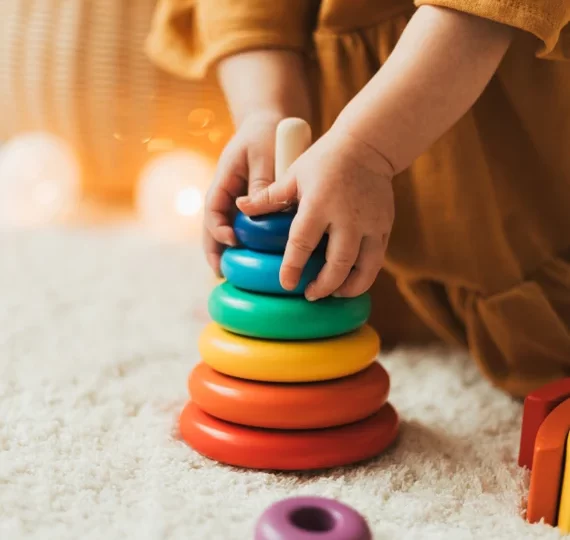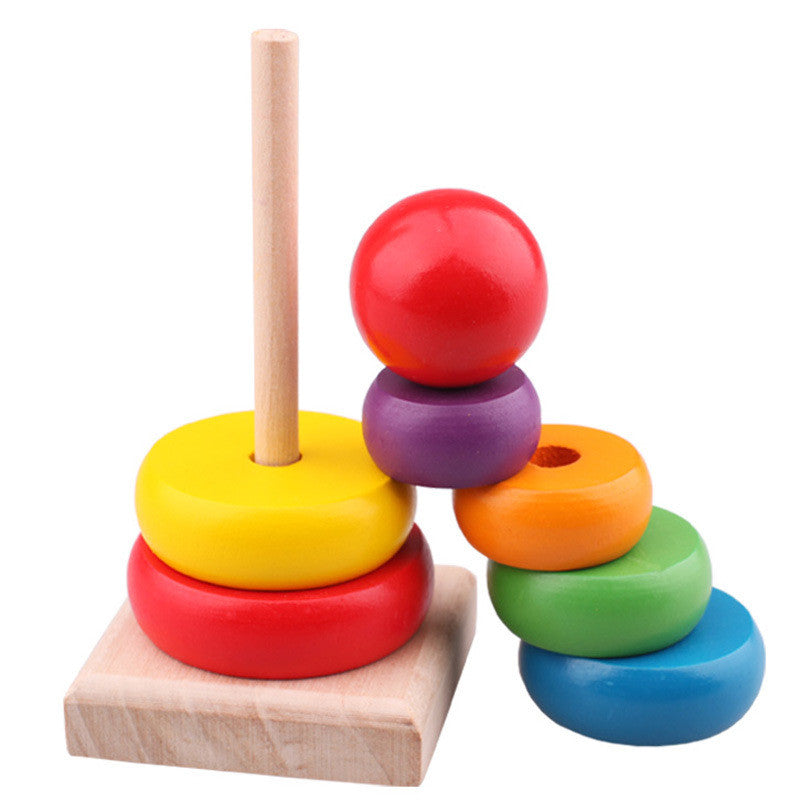
Innovative Baby Wooden Stacking Toy Designs
Historical Evolution of Stacking Toys
The journey of stacking toys is a fascinating story of innovation and development. Early stacking toys were simple rings piled on a cone. They have been around since ancient civilizations. The basic concept was to challenge the child’s motor skills. As time passed, the design of these toys evolved. In the 1900s, wooden stacking toys became popular. They were durable and safe for children. With advancements in manufacturing, these toys gained more intricate shapes. This allowed for a more stimulating experience for a baby’s growth.
It was not just the shapes that evolved. The materials used underwent changes too. Initially, manufacturers used whatever wood was available. Now, they select woods based on safety and sustainability. Paints and finishes have also improved. They are now non-toxic and safer for babies. In the past two decades, designers began incorporating different textures. This move aimed at enhancing sensory development in children.
Today, baby wooden stacking toys come in various themes and styles. Some mimic nature, with animal-shaped pieces. Others have vibrant colors and patterns that capture a child’s attention. Educational elements are also a part of modern designs. They may include numbers, letters, or even simple puzzles. All these changes reflect a deeper understanding of child development. They show the effort to create toys that are more than just playthings.
In recognizing the toy’s history, we appreciate the progression. From basic motor skill development to complex cognitive challenges, baby wooden stacking toys have come a long way. Their evolution mirrors our growing knowledge of early childhood needs.
Importance of Stacking Toys for Early Development
Stacking toys play a crucial role in early childhood development. These toys, especially baby wooden stacking toys, help in the growth of fine motor skills. As children grasp, stack, and sort the pieces, they hone hand-eye coordination. This skill is vital for later complex tasks such as writing and dressing.
These toys also promote cognitive development. Children learn about sizes, shapes, and sequencing as they play. Stacking blocks of different sizes can teach babies the concept of ‘bigger’ and ‘smaller’. This lays the groundwork for understanding numbers and quantities.
Beyond the physical and cognitive, stacking toys encourage problem-solving. Babies experiment with different ways to stack the toys without toppling them. They use trial and error, which fosters critical thinking skills from a young age.
Social and emotional development also benefits from stacking toys. Sharing and taking turns with siblings or parents teaches valuable lessons in cooperation. As children feel the pride of stacking a tall tower, their confidence and self-esteem grow.
Finally, sensory stimulation is a hidden gem in these toys. The texture of the wood, the sound of blocks clinking together, and the sight of colorful painted rings stimulate a baby’s senses. This enhances their overall sensory experience and perception.
In summary, baby wooden stacking toys contribute widely to early development. They touch on many aspects of growth that are fundamental to a child’s formative years. These include motor skills, cognitive abilities, problem-solving, social skills, and sensory development.
Modern Innovations in Wooden Stacking Toy Designs
Wooden stacking toys have undergone creative transformations. Designers focus on combining tradition with modern needs. Here are recent innovations in baby wooden stacking toy designs:
- Interactive Features: Many toys now include movable parts. These encourage babies to explore and engage in more active play.
- Varied Textures: To cater to sensory development, different textures are integrated. Smooth, grooved, and ridged surfaces stimulate a baby’s touch.
- Non-traditional Shapes: Beyond simple rings, today’s toys feature unique shapes. This adds complexity and stimulates creative thinking.
- Bright, Safe Colors: With advancements in non-toxic paints, toys are more colorful. The hues are vivid yet safe for babies to handle and mouth.
- Multifunctional Elements: Some toys serve multiple purposes. They may double as teethers or include rattling pieces to entertain.
- Educational Aspects: Educational layers like alphabets, numbers, or shapes are added. These teach while entertaining, blending play with learning.
These innovations show how designers keep baby wooden stacking toy designs fresh. They balance fun with educational value, keeping safety a priority. This results in toys that are not only entertaining but also beneficial for development.
Safety Considerations for Baby Wooden Stacking Toys
When selecting a baby wooden stacking toy, safety is paramount. Manufacturers and parents alike should be aware of critical safety standards. Here are essential safety considerations for these toys:
- Non-Toxic Materials: Always check that the wooden toys are made with non-toxic materials. This includes the wood itself and any paints or finishes applied.
- Smooth Edges: Toys should have smooth edges to prevent splinters or cuts. All pieces must be sanded down to be safe for little hands.
- Durable Construction: Well-constructed toys do not fall apart easily. They withstand rough play without breaking into small parts that could be a choking hazard.
- Size of Pieces: The toy pieces should be large enough to not pose a choking risk. Avoid any stacking toys with very small parts.
- Age Appropriateness: Choose toys that are developmentally suitable for your child’s age. This ensures that the toy is engaging and safe for them to play with.
- Third-Party Testing: Look for toys that have undergone rigorous safety testing. Certifications from recognized standard organizations add an extra layer of trust.
Always prioritize these safety features when choosing a baby wooden stacking toy to provide a secure playing environment for your child.
Top Materials Used in Making Wooden Stacking Toys
Choosing the right materials for baby wooden stacking toys is crucial. It impacts not just safety, but also the toy’s look, feel, and longevity. Here are the top materials preferred in the manufacturing of wooden stacking toys:
- Hardwood: Durable and resistant to wear, hardwoods like maple and beech are popular. They withstand teething bites and are difficult to splinter.
- Softwood: Pine and cedar are softwoods often used for their lightness and cost-effectiveness. They are easy to shape and good for less intricate pieces.
- Bamboo: Known for its strength and sustainability, bamboo is a eco-friendly choice. It is tough like hardwood and grows quickly, making it a renewable resource.
- Rubberwood: This is a sturdy wood often utilized in eco-conscious toys. Rubberwood trees are harvested for wood only after they stop producing latex. This makes rubberwood an environmentally responsible option.
- Plywood: For toys that need thin, flat elements, plywood is ideal. It’s made by gluing layers of wood veneer together, creating a stable and uniform piece.
In crafting baby wooden stacking toys, non-toxic finishes are also vital. Manufacturers now use water-based paints and natural oils. These materials are safer for babies, especially since toys often end up in their mouths. Always opt for toys that specify the use of non-toxic materials.
The wood’s texture plays a part in sensory stimulation. Smooth surfaces are soothing, while varied grains and patterns offer visual and tactile discovery. Most importantly, no matter the material, it should be sturdy and safe. It should also meet international safety standards to ensure infants’ well-being while they play and learn.
Incorporating Educational Elements in Stacking Toys
Innovation in baby wooden stacking toy designs extends beyond mere shapes and textures. Educational elements have become a cornerstone of modern toy production, serving to entertain and educate simultaneously. Here’s how educational components are integrated into these toys:
- Alphabets and Numbers: Some stacking toys include letters and numbers on their pieces. This helps babies begin to recognize symbols early, aiding in literacy and numeracy development.
- Shape Sorting: Incorporating various shapes, like squares, triangles, and circles, teaches children to differentiate and match, thus improving their spatial awareness and cognitive skills.
- Color Identification: Bright and varied colors are not just for appeal; they help young children learn to identify and name colors, a fundamental skill in early development.
- Puzzles: Simple puzzles that require stacking pieces in a specific order or pattern enhance a child’s problem-solving abilities and logical thinking.
- Interactive Play: Some toys involve moving parts or activities that encourage children to follow sequences or understand cause and effect, vital for cognitive growth.
The value of educational elements in baby wooden stacking toys cannot be overstated. By combining play with learning, children engage in activities that lay the groundwork for school readiness and a lifelong love for learning. Parents and manufacturers must prioritize these features when selecting or creating wooden stacking toys, fostering an enriching playtime experience.
The Role of Sustainability in Baby Toy Manufacturing
The manufacturing of baby toys, particularly those like the baby wooden stacking toy, is now embracing sustainability. As environment-consciousness grows, toy creators are shifting focus. Sustainable practices ensure the future’s health while creating safe toys for children today. Here’s how sustainability is being integrated into toy manufacturing:
- Eco-Friendly Materials: More and more, makers of baby wooden stacking toys opt for renewable resources. Sustainable woods like bamboo and rubberwood replace less eco-friendly alternatives.
- Recycling and Upcycling: Manufacturing processes now include recycling wood waste. Upcycling turns leftover materials into new toys. This lessens waste and makes use of all resources.
- Non-toxic, Biodegradable Paints: The switch to biodegradable, water-based paints means toys are safe for the environment once discarded. These paints break down naturally, unlike traditional paints.
- Minimal Packaging: Reducing plastic and using recyclable materials in packaging is another key shift. Simple, minimal designs lead to less waste.
- Carbon Footprint Reduction: Manufacturers now often seek ways to cut emissions in production. This might include solar-powered facilities or localized sourcing of materials. Reducing transport requirements also lessens carbon output.
- Educating Consumers: Brands engage in teaching buyers about the importance of sustainability. This includes information on how to dispose of toys responsibly.
Sustainability in toy manufacturing isn’t just a trend; it’s a necessity. It protects our children’s future, both environmentally and in fostering a sustainable mindset. The industry’s shift towards eco-friendly practices in creating baby wooden stacking toys is a hopeful sign of a sustainable future in play.
Choosing the Right Wooden Stacking Toy for Your Child
Selecting the perfect baby wooden stacking toy for your child can be a delightful process. There are a few key factors to consider to ensure the toy assists in the child’s development and is safe and enjoyable. Here’s a guide to making the best choice:
- Child’s Age and Abilities: Match the toy with your child’s developmental stage. Simple rings suit younger babies. Older toddlers might enjoy more complex shapes.
- Safety Standards: Ensure the toy meets safety standards. Look for smooth, non-toxic, and appropriately sized pieces to avoid hazards.
- Educational Value: Choose toys that are more than just fun. Look for added features that teach numbers, shapes, or problem-solving skills.
- Material Quality: Inspect for high-quality materials like hardwood or bamboo. These last longer and are safer for teething babies.
- Sensory Experience: Opt for toys with different textures and bright colors. This stimulates multiple senses and enhances learning.
- Sustainability: Consider the environment. Choose toys from companies that use sustainable practices and materials.
By keeping these points in mind, you can find a baby wooden stacking toy that’s not only safe and educational but also a sustainable choice for playful learning.


